In the mid-1800s, Ada Lovelace saw the full potential of computers more than a century before they were a reality.

Wikimedia CommonsLady Ada Lovelace, a British socialite in the 18th Century, was the one of the world’s first computer programmers.
Lady Ada Lovelace, who is often referred to as “the enchantress of numbers,” was a British socialite who became one of the world’s first computer programmers. She loved to learn and — by many accounts — had the natural gift of genius. Later, her footnote translations of an academic paper would be her most indelible contribution to science.
A glimpse into her life up until her untimely death at the age of 36 offers insight into how such a woman was able to make her mark in a man’s world in the early 19th century.
The Daughter Of A Broken Yet Privileged Family
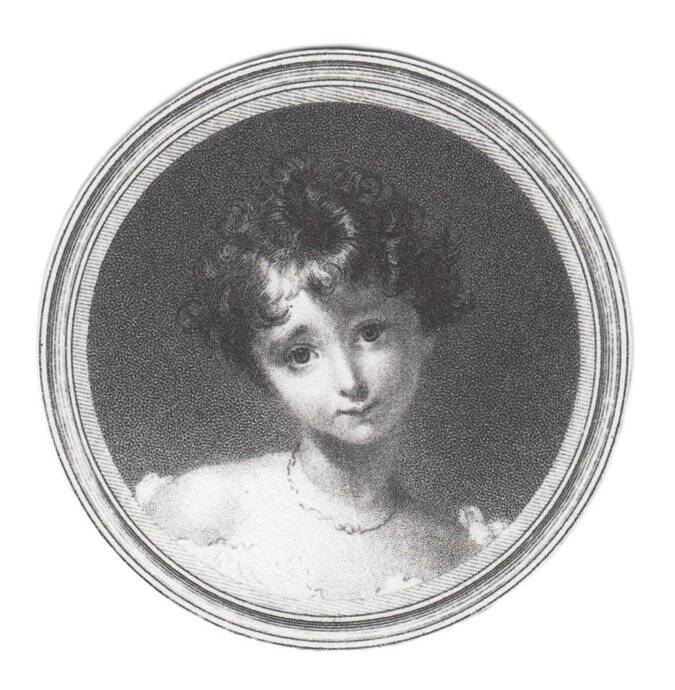
Smith Collection/Gado/Getty ImagesA sketch of young Ada, who was noticeably gifted by her teachers and mentors.
Ada Lovelace’s fascinating biography begins before she was even conceived.
Her father was acclaimed English poet George Gordon Byron, referred to as Lord Byron, while her mother Annabella Milbanke, known as Lady Byron after the two wed, was a successful mathematician. Despite her parents’ accolades and privileges, their union was doomed from the start.
The union was merely a business transaction; Milbanke described the promiscuous poet as “a very bad, very good man” while Byron, in turn, mockingly said that he “should like her more if she were less perfect.” The wedding was a disaster — “Soon as we got into the carriage,” Milbanke later wrote, “his countenance changed to gloom and defiance” — as the poet was mainly after Milbanke’s inheritance.
Byron had a well-known appetite for the ladies but it was not until late that Milbanke discovered her husband was having incestuous affairs with one of her most trusted confidantes: his half-sister Augusta Leigh — who, ironically, their first child had been named after.
By the time Augusta Ada Byron was born on Dec. 10, 1815 to her famous well-to-do parents, her mother was ready to leave her father. Right at the beginning of 1816, Milbanke left Lord Byron and took five-week-old Ada with her.
The scandalous break-up was brought on by three charges for divorce that Milbanke had claimed over Byron, including one charge of homosexuality and heterosexual sodomy, which were both illegal at the time.
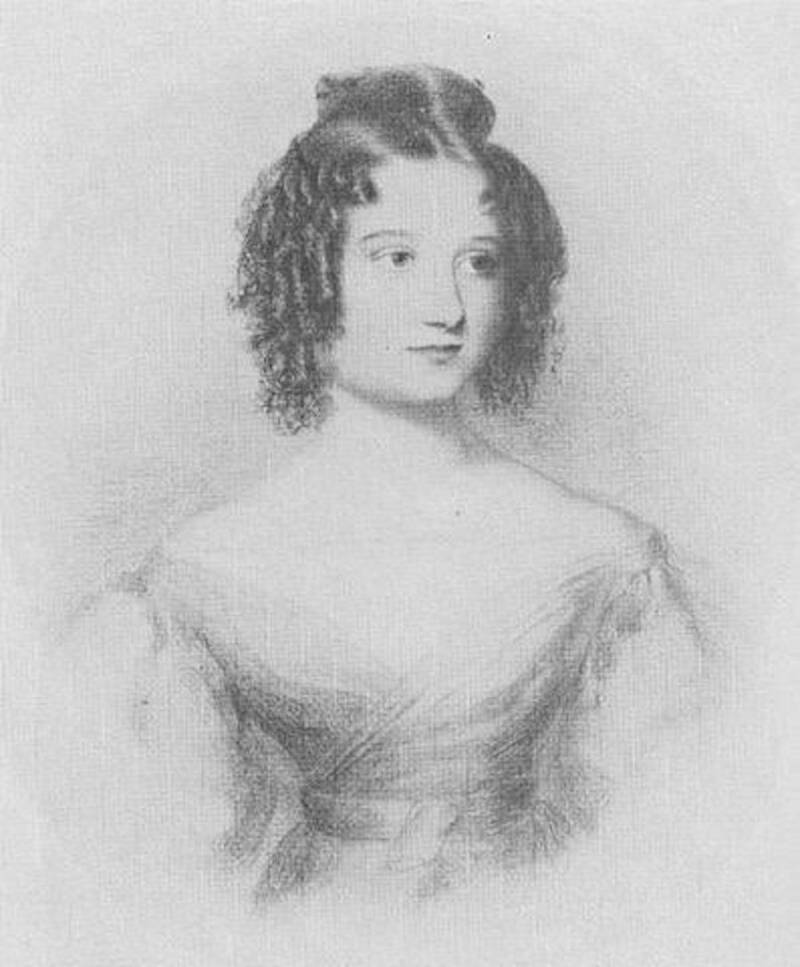
Wikimedia CommonsAda grew up fatherless yet with a strong female figure in her mathematician mother, Annabella Milbanke.
After the charges were doled out, Lord Byron fled England to escape the humiliation. Ada Lovelace would grow up without ever meeting her father. He died when she was eight.
Fresh off the heels of her divorce, Lady Byron dealt with an onslaught of slander. After her ex’s affair with his half-sibling became known to the public, the news only tainted the Lady’s reputation further.
Upon hearing the news of her father’s egregious infidelities years later when she was wed herself, Ada Lovelace shouted, “A new language is requisite to furnish terms strong enough to express my horror and amazement at the appalling facts!” She allegedly claimed the surname Lovelace as a way to distance herself from her father’s corrupt legacy.
Like most single mothers, the widowed Lady Byron was determined to give her daughter some stability in life without the presence of a father. She also made it her mission that Ada become nothing like her floundering dad. To do so, Lady Byron kept her daughter on a strict schedule of lessons and chores — and had her focus her studies on mathematics, not literature.
Ada Lovelace’s Exploration Of ‘Poetical Science’
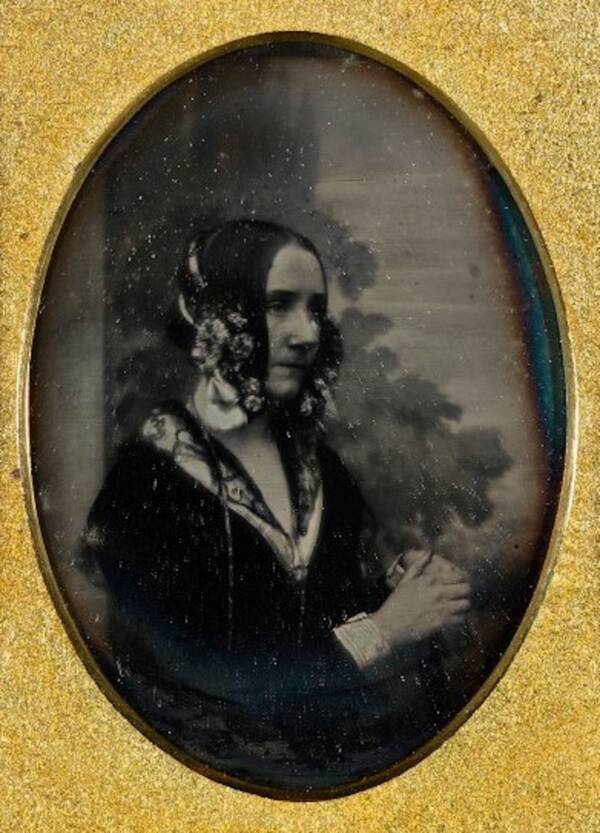
Wikimedia CommonsEven after marriage, she continued to pursue her love of STEM.
Ada was a quick and bright young girl who easily absorbed the lessons she received from her private tutors. Though prone to sickness, she was an energetic child with a wild imagination, often daydreaming of flying in the air. To channel her daughter’s enthusiasm at bay, Lady Byron introduced Ada to her own field of expertise, mathematics.
One of her earlier scientific endeavors was a study of what it would take for her to fly. She analyzed bird wings and came up with the appropriate wing-to-body ratio, determined which materials would most likely support flight, and figured steam would have to be involved. The precocious girl compiled her findings in a book she titled Flyology.
Ada Lovelace’s gift was immediately apparent to those closest to her, including her teachers. Math professor Augustus De Morgan tutored Lovelace and taught her university-level math through a correspondence of letters. Later, De Morgan wrote to her mother, Lady Byron, of the young woman’s brilliance.
If a young male student had her skills, he proclaimed, “they would have certainly made him an original mathematical investigator, perhaps of first-rate eminence.”

Wikimedia CommonsAda Lovelace’s mind was both creative and analytical which experts believe helped her thinking in the exploration of the computer.
Even so, Ada almost became embroiled in a scandal herself having almost eloped with one of her tutors when she was a teenager. Luckily, the potential family crisis managed to be avoided.
Lady Byron’s wealth and class gave Ada access to the best private tutors money could buy, and the brightest minds in England. Among the prominent thinkers that Ada often orbited during her formative years was prominent Scottish scientist Mary Somerville, who was a dear friend of Lady Byron’s.
As was customary at the time among high society, Ada Lovelace made her societal “debut” at age 17. After, Somerville took the fledgling thinker to a salon that was hosted by another exceptional mind, British inventor Charles Babbage.
It was this unlikely friendship with Babbage that would eventually lead Ada unwittingly into the realm of computer science.
Publishing The Very First Computer Code — In Footnotes
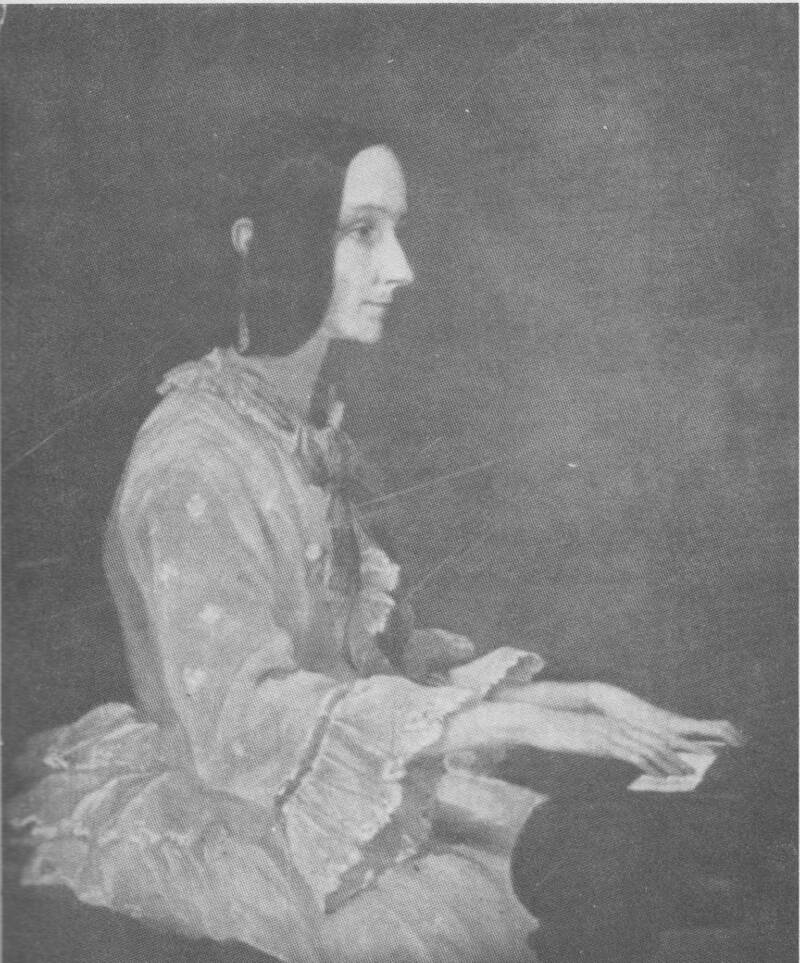
Wikimedia CommonsPainting of Ada Lovelace by Henry Phillips.
Somerville, who became a trusted family friend, also introduced Ada Lovelace to William King. He came from a respectable upbringing and was set to become an Earl, and so he and Ada married in 1835 when she was only 19.
After King received his title as Earl in 1838, his young bride became Lady Ada Lovelace. Taking after her mother, Lady Lovelace would see to it that her married life would not do anything to dampen her academic ambitions, as one of her letters to Somerville conveyed:
“I now read Mathematics every day and am occupied in Trigonometry and in preliminaries to Cubic and Biquadratic Equations. So you see that matrimony has by no means lessened my taste for these pursuits, nor my determination to carry them on.”
She kept this promise to herself even after she gave birth to their three children — two sons and a daughter. Even as a young mother in her early 20s, Ada was still in full pursuit of knowledge and science as she had planned.
Given their shared interests, Ada Lovelace and Charles Babbage became close colleagues despite their striking age difference — he was 43 and she was 17. They connected on an intellectual level and would maintain a healthy correspondence about math and science that would last for almost 20 years.
An early invention by Babbage called the Difference Engine had piqued Ada’s interest from the very first time he showed her the machine. It featured gears and levers that, when pulled, could produce a mathematical solution, making it the first model for the automatic calculator.
The busy machine was the talk of England’s scientific society, and pushed Ada’s natural imagination to wondrous heights.
Ada Lovelace continued to study Babbage’s engines with the intent of translating his work to the public. The two formed a scientific partnership that would last until Babbage wanted to elevate his invention using a concept that he and Ada had observed from the Jacquard loom machine. But instead of weaving flower patterns as the Jacquard did, the new machine would compute algebraic patterns.
Babbage adapted the same principle of the Jacquard loom machine to the plans for his upgraded invention, The machine would create operation cards with patterns that could be inserted into it, and these cards would carry codes of instructions that enabled the machine to perform various calculations.
Thus, Babbage’s newest invention — for which he only ever drafted plans — is referred to as the world’s first computer. He called it the Analytical Engine.
But the potential for this new machine was virtually unknown to the public and even to its own inventor, at least until Lovelace unlocked its full potential. The brilliant mathematician took the information that Babbage had published about his new creation and expanded on it, adding her own lengthy notes about the machine’s capabilities.
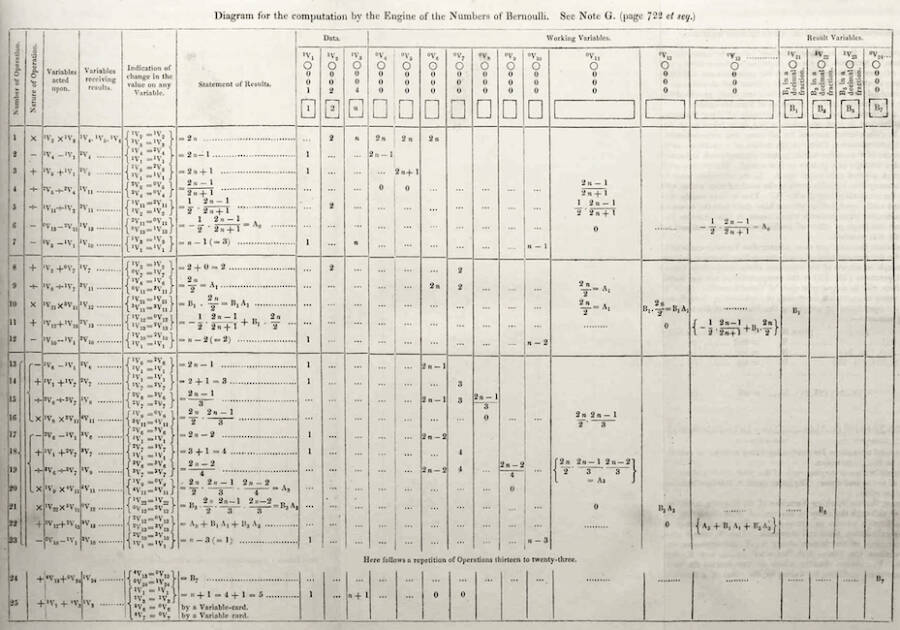
Wikimedia CommonsHer greatest contribution, the world’s first published computer code.
“The Analytical Engine has no pretensions whatever to originate any thing,” she wrote of the machine. “It can do whatever we know how to order it to perform.”
Ada Lovelace’s acclaimed notes — titled, aptly, Notes — were published as an addendum to an Italian paper on Babbage’s Analytical Machine, which she translated. Her notes, in fact, ended up being three times longer than the original paper.
Her pages described the computer’s mechanism, what it was capable of, and a series of programing instructions for the machine’s operating cards.
Just like that, the young scientist had unknowingly etched down the world’s first published lines of computer code by hand. She was only 27 years old at the time.
Some researchers believe Ada’s code was merely a version of one that her mentor, Babbage had previously written down. But, even still, her contributions to computer science didn’t end there.
She was the first to understand how computers had the potential to do much more than spew out numbers. In her mind, they could produce things far more artistic and abstract.
“Supposing,” she wrote, “that the fundamental relations of pitched sounds in the science of harmony and of musical composition were susceptible of such expression and adaptations, the engine might compose elaborate and scientific pieces of music of any degree of complexity or extent.”
She even foresaw the computer’s implications for the yet-to-be-established field of artificial intelligence: “The Analytical Engine has no pretensions whatever to originate anything,” she declared. “It can do whatever we know how to order it to perform. It can follow analysis; but it has no power of anticipating any analytical relations or truths.”
Lady Lovelace’s Enduring Influence

Wikimedia CommonsAda Lovelace Day is celebrated every October to honor women scientists like her.
Unfortunately, like many geniuses that go unrecognized during their time, the Analytical Engine dreamed up by Charles Babbage and ultimately supported by Ada Lovelace was largely ignored by the scientific field. The bold propositions that Lovelace believed the machine could drum up were simply unthinkable to engineers at the time.
Further, Babbage’s Difference machine had also turned into a flop after it got caught in a financial hurdle (the machine required thousands of metal parts, at great cost). Neither of these sophisticated machines went anywhere when they were first invented. Yet, now, our daily lives seem unimaginable without the aid of computers.
Ada Lovelace’s notes became the foundation that helped usher in the digital age, but her big breakthrough went largely unnoticed. A decade later she died of uterine cancer at the age of 36 — the same age her father was when he died. She requested to be buried next to him, even though she never knew him.
Ada’s work with Babbage and the old analytics machine were rediscovered in the mid-20th century. Her contributions were so great that the U.S. Department of Defense named its high-order computer programming language “Ada” in honor of the late scientist, and each October Ada Lovelace Day is meant to celebrate women in science, technology, engineering, and mathematics.
Back then, women with a powerful mind like hers were deemed “unfeminine” or “unladylike”; even her obituary in the London Examiner described her brilliance as “thoroughly masculine.”
https://www.youtube.com/watch?v=sB5ieSGGDmk
Her understanding of the depth of the analytical computing of Babbage’s machine was the hallmark of a new era.
“[Ada Lovelace’s] insight would become the core concept of the digital age,” Walter Isaacson wrote in his book The Innovators. “Any piece of content, data or information — music, text, pictures, numbers, symbols, sounds, video — could be expressed in digital form and manipulated by machines.”
Even Charles Babbage, regarded as a great scientist and inventor, dubbed his young counterpart as the “enchantress of numbers,” writing that she “has thrown her magical spell around the most abstract of Sciences and has grasped it with a force which few masculine intellects (in our own country at least) could have exerted over it.”
At a time when women were not expected to be prominent thinkers and creators, Lovelace’s brilliance shone through and defied the antiquated dictations of what it meant to be a Lady and a scientist.
Now that you’ve learned about 18th century computer programer Ada Lovelace’s life and discoveries, read about Anastasia Romanov, the elusive daughter of Russia’s last czar. Then, learn the story of the Shieldmaidens, the Viking warrior women.





